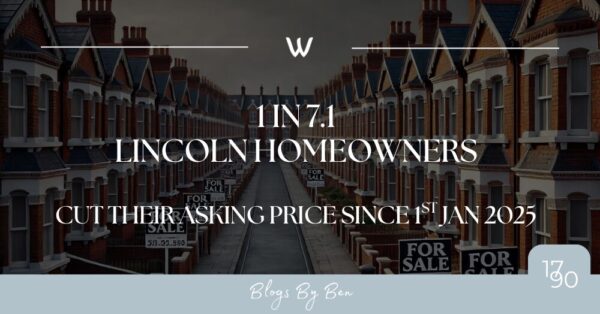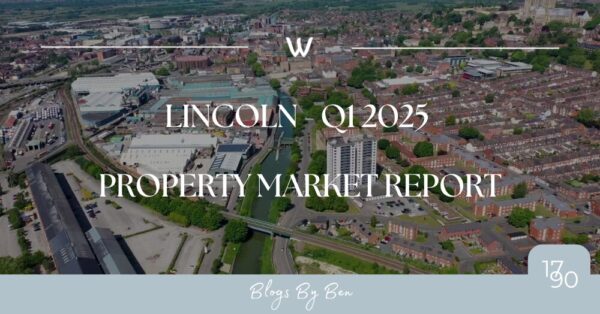Lincoln property prices have increased by 16.5% over the last two years.
Lincoln house prices have risen on the back of several things, including changes in how people see their homes and how they live and work (i.e., working from home), a lack of properties on the market and government tax incentives (the stamp duty holiday in 2020).
Yet, the tide could be beginning to turn as the number of houses coming on the market is increasing as supply is starting to catch up with demand – in Q1 2022, 389,811 properties came onto the market in the UK compared to 425,295 in Q2 2022. One would typically expect Q1 to be larger than Q2 in average years.
Yet some commentators are saying one thing that could stifle this growth is the cost-of-living crisis.
I wanted to delve deeper into what was happening in Lincoln instead of reading headlines in the newspapers. Let me start with average incomes.
The average Lincoln household income is £707.90 per week, compared to £581.80 in the West Midlands region and £613.10 nationally.
Roll the clock back twenty years to 2002, and the average Lincoln household income was £416.20.
I wanted to go into greater detail a few weeks ago; I stated that mortgage costs for first-time buyers were much lower today (as a percentage of household income) than in 1989 and 2007. Many of you commented on social media or sent me messages asking what happened to other household bills.
In 1989, 16% of people’s household income went on housing (rent or mortgage) compared to 17.5% in 2021.
Food represented 19% of people’s spending in 1989, compared to 14.4% in 2021.
Also, gas and electricity were 6% of household income in 1989 compared to 4.81% in 2021.
(although that was before we saw the recent energy price hikes)
Interestingly, the UK household spent 15% of their monthly income on leisure activities in 2021, compared to 10% in 1989.
Household goods and services (i.e. household appliances, insurance etc.) have risen from 11% in 1989 to 14.9% in 2021.
Before I leave these stats, I had a peek at the 1957 stats (the earliest stats available), and in that year, food represented 33% of the household income and tobacco 6% (today, it’s 2.34%).
So, compared to 1989, the big-ticket items of housing, food and fuel combined have gone down from 41% to 36.7% of the household income, whilst leisure has increased from 10% to 15%.
The fuel element of household bills will rise to around 11% to 12% of household income, and I suspect the leisure budget will be hit the hardest to pay for that. We are seeing food inflation of around 10% to 15%, meaning that food will go from its current 14.4% of household income to around 16% to 17%.
It’s going to be tough, especially for those people in rented accommodation who may not earn near the average wage yet, as they have similar fixed costs for gas, electricity and food.
Next, let me look at the inflationary effects on housing costs.
A rise in the base rate will, in theory, slow inflation by reducing consumer demand. In the short-term, this increase in the base rate will increase mortgage rates, thus adding fuel to the fire of the cost-of-living crisis by growing mortgage costs.
Those Lincoln homeowners on tracker or variable rate mortgages will instantly increase their mortgage payments.
Encouragingly though, just under 17 out of 20 people are on fixed-rate mortgages, the majority on 5-year fixed rate deals, so their housing costs won’t go up significantly in the short-term.
This will alleviate some of the interest rate effects, making it more challenging and expensive for new borrowers like first-time buyers.
However, as I have explained in previous articles on the Lincoln property market, many Lincoln landlords have been sitting on their hands in the last couple of years as owner-occupiers have outbid each other in buying their next ‘forever home’. If there aren’t going to be so many Lincolns first-time buyers, then I suspect we might see more Lincoln landlords coming out of the woodwork and buying again.
This is especially true as investing in buy-to-let in inflationary times is an excellent hedge to protecting the buying power of your hard-earned savings (drop me a message if you want to read that article).
In conclusion, although the amalgamation of the Lincoln house price rises in the last two years, the increasing interest rate rises, and the continuing cost-of-living crisis, there is no doubt the momentum in the Lincoln housing market will be slower in the next 12 months compared to the last 24 months. Nevertheless, I anticipate Lincoln house price growth will ease (and, in some months, be slightly negative). A better bellwether of the state of the Lincoln property market is the number of people moving house (i.e., the transaction levels).
I expect transaction levels to be lower in the latter part of this year and the first half of 2023, yet they are most likely to stay close to the long-term average. The boom is over, yet it shouldn’t be a bust situation.
What are your thoughts on this? Let me know.



